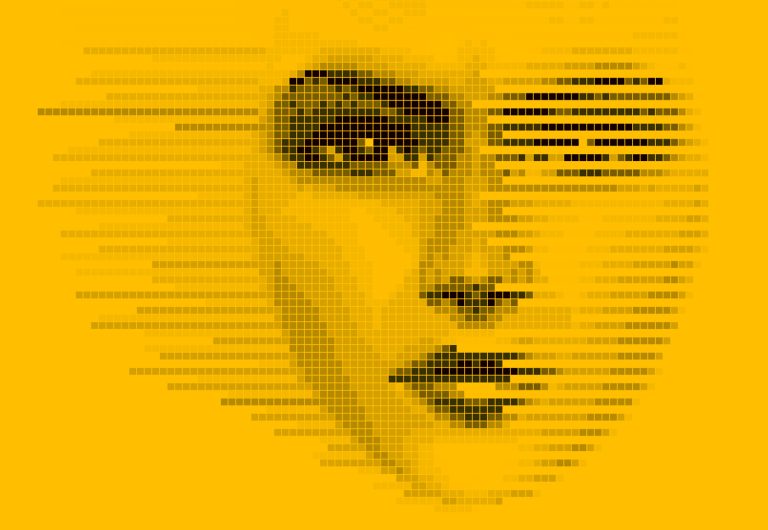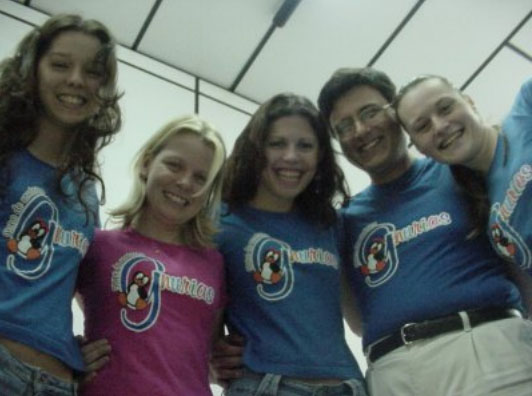History of Women in Computing: GNU Girls

The computer field—and especially free and open source software—has to work harder to be friendly to women and non-binary participants. We could do well to look at a little-known group called GNU Girls that helped to change the field between 2001 and 2008.
Women’s actual participation in computing has varied a lot over time and varies between regions. One source of research finds that only 18% of computer professionals are currently women, while another is more optimistic at 30%. Informally, from reading documents, gazing around conferences, and (pre-pandemic) visiting offices, it seems that men unduly predominate.
But the free and open source communities do even worse in under-representation: women’s participation has been estimated at less than 10%.
The start of GNUrias

Berner, Joice Käfer-Marrero, Cesar Brod (GNURias Godfather)
and Ana Paula Fiegenbaum, circa 2003.
In 1999 I started working as a consultant for Univates, a superior educational institution that had not yet become the university it is today. My mission was to form a development team who would build an academic administration system. This system would later become the main product of a free and open source software development and solutions integration co-operative, founded in 2003. All of the ICT people in the institution were men, and because we would need more people to join our team as we grew it, we understood we needed to be more inclusive. So besides hiring more women, we created incentives for them to reach out to our working group. Soon we welcomed more women into a very receptive Linux Users Group named GNUrias.
Participants the free and open source community know that GNU comes from the recursive acronym “GNU is Not Unix”—the free operating system envisioned by Richard Stallman and the Free Software Foundation, long praised as a stand-in for the entire free and open source software trend.. If you are not from the south of Brazil, however, you probably don’t know what GURIA is. Guri and Guria are the terms used in this region to refer to boys and girls. So, GNURias actually stands for the “GNU Girls.”
The GNURias Linux User Group was created in 2001 and soon became quite popular, especially due to the educational programs aimed toward children and senior citizens.
Kids from nearby schools would come to the Univates’s IT labs and learn how they could use computers and the internet as a way of learning better the things they were studying at their schools, guided by the GNURias. At the time, computers were not that common in these kids’s households, and for many their first contact with computers was with the Linux operating systems running Firefox, GCompris, Little Wizard, and other applications that would make sense for them. When the schools were able to get their own labs, the GNURias were invited to help install Linux in them. The few kids that had computers at home would say that the “Windows” they used at school was better than the one they had at home.
The region where Univates is located was settled by original German and Italian colonies in the nineteenth century. So in the classes for senior citizens, the GNURias told them how to use the internet and email to know more about the origin of their families, and this allowed them to reconnect with their people still living and Europe. This educational measure also fostered tourism in the region as people from Italy and Germany started visiting their relatives in the south of Brazil and vice versa. Some works of genealogy and books were published later thanks to this initiative, tracking the whole family trees of several families.
In the first World Social Forum in 2001, Timothy Ney, the CFO of the Free Software Foundation at the time, participated as a speaker and was hosted by our team at Univates. He was quite impressed by the things we were doing at the time and, in the following year, Richard Stallman, president of the FSF, came to Brazil for the same forum. At the time, the GNUrias were hosting an IT nursery for the children of the landless, homeless workers, and other movements, when their parents were attending meetings in the forums. The children would stay in tents filled with computers lent by the Debian community. There, the GNURias and other volunteers would guide the children in representing paper paintings and other works as computer art, mostly using Tux Paint. CDs were given to their parents along with contact info so they could get help installing Linux and related educational software.
The GNURias then started to give presentations and workshops all over the country, as well as several places around Latin America, and even participated in the Linux Conf Australia. From 2003 onword, a lot of their work ended up being covered in the Brazilian national press. There is still a lot of information available if you search for GNURIAS on Google.
The group disbanded in 2008, mostly because their original members graduated from the University and started to get jobs in several different organizations. Their work, however, has been taken over by several gender-specific groups both in Brazil and all over the world, such as Rails Girls, educaTRANSforma, Mulheres na TI (Woman in IT), KDE Women, and others.
Do you know a Free and Open Source related women’s organization you would like to have showcased by the Linux Professional Institute? Let us know in the comments.
